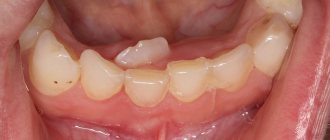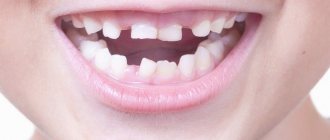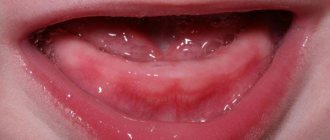A lot has already been said about teething and related problems, many articles have been written, lectures have been given and information has been transmitted from pediatricians. Most parents, long before the start of the process, mentally prepare for the fact that the child will often cry, be capricious, refuse to eat and wake up at night. But there are also problems that are covered in less detail. In particular, one of these problems is a rash on the child’s skin. Is this normal, how to prevent it and how to fight it - we will try to answer all these questions.
As a rule, the first tooth (usually the lower incisor, but there may be variations) begins to appear between 3 months and 1 year of the child’s life. At this time, the same rash associated with teething may form on the child’s skin. It is localized on various parts of the body. Can teething cause a rash on the body or face? Let's figure it out together.
All symptoms of teething are divided into frequently occurring and more rare.
More common ones include:
- Redness of the gums
during teething. - Redness on the face
in the area around the mouth and on the chin. - Increased nervous excitability
in a child. - Lost appetite.
- Heavy salivation.
The fight against all these symptoms is given a significant place among all the articles about the health of the baby during the period of active teething. Let's consider one of the rarer symptoms, namely a rash due to teething.
Causes of the rash
Due to the fact that the baby is going through a period of adaptation to the environment in his life, rashes on the body are not something supernatural. This is how a very small organism perceives life changes.
Often this phenomenon is due to completely different reasons that have nothing to do with the growth of baby teeth.
The following reasons are probable:
- The body's sensitivity to innovations in nutrition.
- Allergy to household chemicals.
- Excessive salivation as baby teeth grow.
- Genetic predisposition to allergies.
- The influence of external stimuli on a young, fragile organism.
Teething
Skin rashes may appear as a result of exposure to one of the listed factors.
It is very difficult to understand the true cause of irritation and say unambiguously whether it is related to tooth growth or not. Taking into account the true cause of the rash, appropriate therapy is prescribed.
Rash and teething: how they are connected
It's no secret that during the period of growth of baby teeth, babies become very irritable, as the process is accompanied by severe pain and discomfort. The baby sleeps little, his gums itch, and he cries constantly. Due to severe stress, salivation increases.
The occurrence of a rash is caused by the body's reaction to such a shock. A teething rash, as in the photo below, has a special medical name - “cytokine explosion.”
The appearance of rashes in a baby may be due to a reaction to some unknown product, household chemicals, or clothing. An infection may be to blame. In order to correctly determine the appearance of irritation on the skin, it is necessary to undergo a special medical examination and pass all the necessary tests.
Taking into account the results of the examination, therapeutic tactics are determined.
Diagnostic methods
When this disease develops, the patient or his parents are interviewed and the symptoms are analyzed.
The doctor can make a preliminary diagnosis after examining the child’s skin. A rash with urticaria is difficult to confuse with another. However, to exclude errors and establish the cause, tests are prescribed:
- stool analysis, which will help identify parasites - they can be pathogens;
- general blood test - identifies or excludes inflammatory and immune processes;
- allergy tests - skin tests to identify the pathogen;
- liver tests - to determine liver function and exclude its pathologies.
Thyroid function may be tested because the disease can be caused by hypo- or hyperthyroidism.
Localization of rashes
There are likely to be different stages and phasing of the appearance of rashes in a baby as a result of teething. Most often, skin irritation makes itself felt in the neck area. The process then spreads to the limbs, abdomen and other parts of the baby’s body.
The rash on the teeth may be dry, somewhat rough, and accompanied by a strong burning sensation. Often the nature of the occurrence of such a phenomenon affects not only close people around the baby, but also experienced doctors.
It is worth emphasizing once again that this is a peculiar reaction of the body to many provocateurs, each of which requires special attention.
Rashes on the body
Most often, a rash on a child’s teeth appears in the most visible areas - the neck and face.
A similar phenomenon occurs in many places. It may be difficult to see and roughness may form on the baby’s skin. This phenomenon can be due to many reasons:
- baby's reaction to stressful stimuli . This period in a child’s life is very difficult and simply cannot be completely painless. At the same time, the load on the psyche increases significantly;
- Another serious cause of this phenomenon may be a lack of calcium. This is due to the simultaneous eruption of several teeth, which implies the need for an increased dose of calcium. The lack of this component is reflected in skin rashes.
Skin reactions should never be ignored. At the time of occurrence, you should not buy new clothes for your baby; all things, household chemicals and household items should be hypoallergenic. You should also not forget about nutrition; be sure to adjust your child’s diet.
Differences between diarrhea and loose stools
A sign of diarrhea in a child may be sudden bowel movements.
Since infants eat mainly liquid food, the consistency of their stool is also quite rare. Loose stools in children under one year of age are absolutely normal, which cannot be said about adults and older children. Signs of diarrhea in a child:
- frequent bowel movements;
- a sharp sour smell of feces appears;
- the consistency of the stool becomes even more liquid, similar to water;
- sudden bowel movement;
- pronounced green/yellow color of stool;
- impurities of blood, mucus or foam appear;
- elevated temperature;
- vomit;
- the child becomes lethargic and weak.
If your child has some of the above signs, then you should not delay a visit to your specialist.
A baby who sleeps poorly, eats without appetite or refuses food, and is naughty cannot be completely healthy.
Signs on the face
Most often, a rash on a child’s teeth makes itself felt in the most visible areas – the neck and face. Folk remedies usually do not help with such phenomena, since self-diagnosis by parents, grandmothers and other family members cannot be correct. This requires a professional approach.
It is worth noting that the use of various ointments in infants for other purposes does not usually end well , but only entails a number of unpleasant consequences. It makes sense to undergo a full examination in order to establish the correct diagnosis.
A characteristic phenomenon often occurs due to banal non-compliance with hygienic principles by the baby’s parents. This is especially evident when using low-quality household chemicals . That is why cosmetics, detergents and laundry detergents for babies should be selected very carefully.
During the period of growth of baby teeth, a baby's immunity weakens due to severe stress, which results in rashes on the face.
Features of newborn digestion
Dysbacteriosis is the cause of colic
The child, while in the womb, is surrounded by an exclusively sterile environment. During this period of development, the child learns about all bacteria with the help of maternal antibodies. When a child passes through the birth canal, he encounters various bacteria along the way.
The first bacterium is Dederlein's bacillus, which belongs to fermented milk microorganisms.
After communicating with the mother, the child becomes acquainted with other bacteria. Colostrum includes bifidobacteria, which form the microflora of the baby's stomach. Thanks to this, it is concluded that when breastfeeding, dysbiosis does not threaten the baby. With artificial or mixed feeding, the likelihood of dysbiosis in the baby is higher.
Time passes and the child’s microflora changes in a natural physical way, and this can lead to dysbacteriosis in the infant, which will disappear in a very short period of time. And such dysbacteriosis does not manifest itself with any special negative signs. It is also worth recalling that the baby’s stomach is not always populated by the bacteria genetically inherent in the newborn. In this case, everything will directly depend on the child’s body and how it can adapt to them.
Most experienced pediatricians believe that such an imbalance develops in newborns due to late attachment to the mother's breast. This theory is especially actively supported by supporters of breastfeeding babies. It should be said that they are certainly right.
If a child receives maternal nutrition during the first three hours of life, then he will receive all the bacteria necessary for him, which can maximally protect the child from dysbacteriosis. If this does not happen, then bacteria will enter the newborn’s stomach, which he will sooner or later encounter in the children’s department.
Burning and rash on the neck
When a rash appears, it is recommended to give the child herbal baths.
It is worth noting that the rashes do not appear on their own. Usually, symptoms during teething occur all in a heap: irritability, intense salivation, fever. In this situation, herbal baths are very effective.
It is useful to take baths with celandine, chamomile and other anti-inflammatory plants . After the bathing procedure, it is advisable to lubricate the baby’s body with healing ointments. In this situation, good old baby cream often saves the day. You can use special creams containing panthenol.
Aerial procedures have a special effect. With severe burning, even the use of soft clothing has a strong irritating effect. Air baths provide effective treatment for skin rashes.
Treatment methods for urticaria in children
This disease should be treated depending on its form. The pseudoallergic variety requires examination for the underlying disease. Allergic – allergen exclusion and immunotherapy.
In the acute period:
- eliminate contact with the allergen;
- the child is prescribed a hypoallergenic diet for several days;
- remove the allergen from the body, prescribe plenty of fluids;
- use sorbents and antihistamines (types and dosage regimen are determined only with a doctor);
- for severe swelling, a specialist may prescribe a diuretic;
- Prescribe antipruritic ointments for the arms, legs, or other areas of the child’s body that are prone to hives.
Parents should carefully monitor the cleanliness of the house and promptly wash clothes and bedding with hypoallergenic products.
How to speed up the process
Often, adults look forward to teething, but there are still no symptoms. What to do in this situation? Until the tooth grows completely, the process is accompanied by many difficulties. The very first obstacle is the bone and crown. After this, the tooth also overcomes the mucous part, which is quite difficult, because this tissue is quite elastic.
To stimulate the teething process, the baby’s saliva contains special components that straighten the mucous membrane and promote the rupture and birth of the tooth. In addition, baby saliva is an antibacterial liquid that helps fight infection, which often occurs as a result of tooth growth.
Adults should take note of the fact that it is impossible to speed up the natural process of tooth growth. This is not at all practical or relevant. No drugs will help.
All products containing calcium will be excreted from the body and absorbed only in small quantities. Moreover, a lack of calcium has nothing to do with it. Medicine does not yet know a clear answer to the question of what exactly causes teething.
The main theory is the formation of the root of the baby tooth , which stimulates the movement of the latter. Of course, growth requires nutrients, but it also takes time for cells to divide.
Teethers help ease your baby's teething condition.
Particularly brave parents decide to undertake the absurd procedure of cutting gums on their own. Such measures are unacceptable. First of all, you will cause severe pain and injure the tissues of the tooth that has not yet sprouted, and also cause an infection.
Such manipulation is done only in dental offices and is used only to stimulate the growth of figure eights.
To alleviate the baby's condition by speeding up the teething process, he needs to be given special teethers. All hard and tough products are suitable for this purpose. Never give your baby a sugar cube . This is a grave mistake that many grandmothers make.









